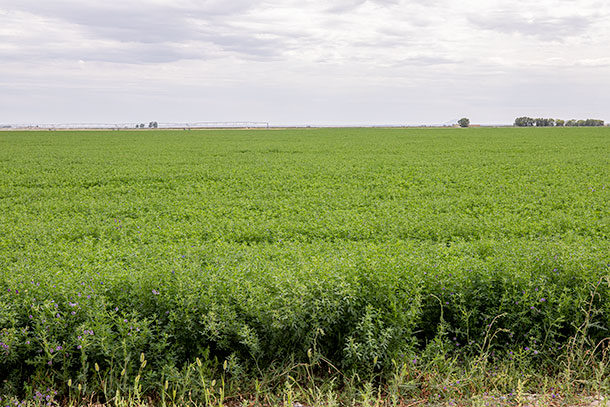Studies have shown that when alfalfa is included in a ration, dairy cattle will have higher milk protein production, as well as improved intake and digestibility. Additionally, because it is a great source of effective fiber as well as calcium, it also can carry a lower risk for rumen acidosis compared to higher-starch feeds. But besides these well-known animal benefits, what are other factors in alfalfa’s case for sustainability?
Alfalfa’s impacts on soil health have been widely studied for many years. Because it is a perennial, alfalfa requires less tillage and has even been found to increase soil carbon over time. Studies have found that the amount of soil organic carbon sequestered by alfalfa significantly increased over a continuous corn and soybean rotation, improving soil resiliency. Alfalfa also helps to reduce erosion through its perennial growth habit and extensive root system. It also improves soil water and nutrient penetration and overall soil tilth. Also aiding in creating a more stable environment, alfalfa can be used to help manage water tables, prevent nitrate leaching, remediate saline seeps and even mitigate chemical spills.
Another huge benefit of alfalfa is the ability to add nitrogen to the soil via biological nitrogen fixation. As alfalfa is a perennial legume, it forms an important symbiosis with rhizobium species, which provides the ability to utilize atmospheric nitrogen and convert it to usable plant protein. When the nodules decompose, the nitrogen contained within them is assimilated into the soil and made available for the next plant, also called a nitrogen credit. Compared to a popular annual legume, soybean, research estimates you can expect well over a 100 pounds nitrogen per acre increase with alfalfa. Research has also found this is not just a one-time availability, but rather there can be benefits seen for many years after the stand is terminated. When estimating how much of a “credit” you can expect, factors such as stand health, age, soil type and management all play a role in the true realized nitrogen credit potential.
On the opposite end of the spectrum, alfalfa can also be useful in removing excessive levels of nutrients, including large amounts of metals in the soils that may otherwise be toxic. It can also help consume high levels of nitrates in the soil and has been used in fields that have a long history of problems with nitrates, as it is able to efficiently consume the available nitrates. This can help decrease the amount of nitrates leaching into groundwater, as well as make fields “safer” when trying to grow nitrate-accumulating crops such as oats.
Alfalfa is a great way to help diversify your on-farm portfolio, especially compared to a continuous cropping system. Many times, alfalfa can make a lot of economic sense to many producers. Research has found that alfalfa productivity and yield is the largest determining factor in profit margins, but a healthy, vigorous stand that can be established quickly can significantly improve profits. Because alfalfa doesn’t have a large nitrogen fertilizer requirement, it can help decrease overall costs of management. This does not mean you can skimp on other nutrients, as alfalfa does have large requirements for nutrients like phosphorous, but it means there may be one fertilizer you can cross off your list.
Finally, alfalfa is also an extremely important habitat system. It is home to hundreds of species of arthropods, as well as wildlife. Studies have found anywhere from 500 to 1,000 different species of insects living within a single alfalfa field. Wildlife also rely on alfalfa fields as sources of food, from insects to small mammals, as well as large areas for hunting. It provides great cover due to its dense canopy for insects and small mammals, which can in turn attract predators such as hawks, owls and snakes. Mammals, including deer and antelope, often use alfalfa fields as a foraging source, which may or may not be a good thing depending on who you ask. It is also important to many pollinator species, who also play a critical role in alfalfa production.
Overall, alfalfa has a lot to offer agriculture. It is a great source of nutrition for consuming livestock and wildlife and provides many soil benefits we are just beginning to understand. Its perennial growth habit helps it to provide protection to soils as well as insects and wildlife and makes fields more resilient to environmental stresses. For many, including alfalfa in your cropping rotations makes sense to consider, and you won’t be disappointed. ![]()
PHOTO: If you're looking for that "farm fix" that helps soil, nutrients, wildlife and still brings an income, alfalfa is your answer. Staff photo.
Emily Meccage is a technical support specialist for Forage Genetics International. Email Emily Maccage.











